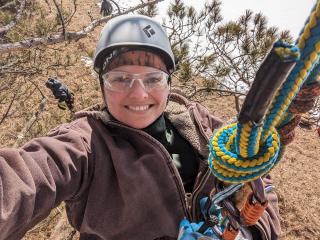National Tree Climbing Program

The National Tree Climbing Program has been developed in an ongoing effort to ensure the safety of USDA Forest Service tree climbers and the integrity of existing climbing activities. The program is defined in FSH 2409.17-2009-1 Tree Climbing Program. The policy sets forth the standards to be followed for all Forest Service tree climbing work and was derived from recognized industry standards, procedures and practices, as well as appropriate related material contained in FSH 6709.11, Health and Safety Code Handbook, and the USDA Forest Service National Tree Climbing Field Guide (PDF, 7.8 MB).
Program staff includes program and deputy program managers, region, station, area and institute tree climbing coordinators and technical advisors as needed. A tree climbing technical advisory group meets yearly to discuss changes relative to Forest Service tree climbing equipment, techniques and practices, and to provide overall program recommendations. View the contacts section of this webpage for names of those serving in program capacities, and other personnel associated with tree climbing work. The organizational structure provided for in the program will allow for the timely dissemination of safety information, equipment and technique updates, requests for training and/or climbing assistance and defining the tree climbing cadre and concurrent distribution of skills on a nationwide basis.
The majority of Forest Service tree climbing activities in the western United States have been confined to conifers. As a result, the climbing techniques and safety standards which have been developed over time, primarily from input from western climbers, and collected in the National Tree Climbing Guide, reflect this. Typical methods for accessing hardwoods have only recently been explored and addressed by agency tree climbers. This has largely been in response to the need for climbers to support the Asian longhorned beetle project operated by USDA Animal and Plant Health Inspection Service in Chicago, New York and New Jersey. This introduced exotic pest only attacks hardwoods and the most successful method of detection to date has been a thorough visual examination throughout the tree by a trained and experienced tree climber. Smokejumpers have become the climbers of choice in this important and demanding work.
Climbing and working in trees demands specialized equipment and skills. The potential for a serious injury or fatal fall is always present, so employees must be well trained and certified before they perform tree climbing work. Now that national program direction has been issued, all Forest Service tree climbers will have to be trained and certified through Dorena or other recognized training source. Written materials, like the National Tree Climbing Guide, revised and now available from the Missoula Technology Development Center, play an important role in acquiring knowledge of tree climbing techniques. But no amount of reading can make a person a safe and efficient tree climber; that takes proper training and practice. Practice under the guidance of an experienced and competent instructor or certified climber will help to ensure the safety of new climbers and maintain the integrity of the National Tree Climbing program.
